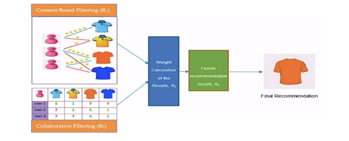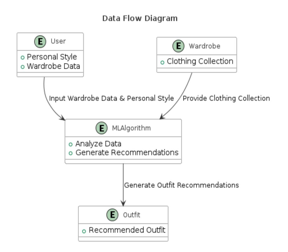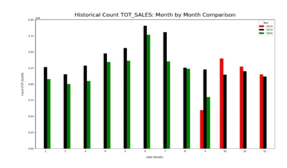Ijraset Journal For Research in Applied Science and Engineering Technology
- Home / Ijraset
- On This Page
- Abstract
- Introduction
- Conclusion
- References
- Copyright
Personalised Outfit Recommendation System Using Deep Learning
Authors: Sarthak Vyavahare, Kriish Gulati, Sahil Hujare, Godwin Thomas
DOI Link: https://doi.org/10.22214/ijraset.2024.60349
Certificate: View Certificate
Abstract
Fashion engineering presents a significant challenge in efficiently coordinating outfits to suit personal preferences. In this study, we introduce a Fashion Coordination Assistant featuring a hybrid recommendation system. Our approach combines content-based and collaborative filtering techniques, utilizing Singular Value Decomposition (SVD) and Non-negative Matrix Factorization (NMF) algorithms. By thoroughly analyzing clothing characteristics and user behavior, we address the technical complexities of fashion coordination. Leveraging the latent features identified by SVD and the non-linear relationships captured by NMF, our system generates tailored outfit suggestions based on individual preferences and style profiles. Extensive testing validates the system\'s ability to provide diverse and efficient recommendations. By integrating innovative recommendation methods, the Fashion Coordination Assistant adapts to evolving fashion trends and user preferences, enhancing its practical utility in real-world scenarios
Introduction
I. INTRODUCTION
Fashion serves as a canvas for expressing individuality, emotions, and aspirations. Yet, the vast array of style options and ever-evolving trends can overwhelm even the most seasoned fashion enthusiasts. This study aims to simplify the process of creating stylish outfits, empowering individuals to make confident wardrobe choices.
At the heart of this initiative lies a robust recommendation engine, blending content-based and collaborative filtering techniques. Seamlessly integrating these methods, the system leverages advanced algorithms like Singular Value Decomposition (SVD) and Non-negative Matrix Factorization (NMF) to ensure unparalleled accuracy and relevance in recommendations.
Here's how it operates: the assistant begins by assessing the user's specific fashion preferences, including past clothing purchases, style influences, and social media connections. Employing content-based filtering, it identifies garments with features akin to the user's preferences, ensuring suggestions closely align with their established tastes.
Moreover, the assistant doesn't operate in isolation; it taps into the collective wisdom of a community of fashion aficionados through collaborative filtering. By examining the fashion inclinations of like-minded individuals, it enriches its recommendations with diverse and contemporary suggestions, infusing each outfit idea with freshness and creativity.
The recommendation engine is underpinned by sophisticated techniques such as SVD, which extracts latent features from the fashion dataset to enhance recommendation accuracy and personalization. Additionally, the incorporation of NMF delves into the complexities of deep learning, enabling the assistant to discern intricate relationships between clothing items and user preferences, thereby refining recommendations with each interaction.
In essence, the Fashion Coordination Assistant serves as a trusted companion in the pursuit of sartorial excellence. Users can rely on this intuitive tool to effortlessly navigate the fashion landscape, whether seeking inspiration for everyday ensembles, preparing for special occasions, or exploring new style avenues. Through the Fashion Coordination Assistant, individuals can unlock their full fashion potential and express their unique identity through their clothing choices.

A. The Challenges and Limitations Identified in the Previous Studies by Different Authors
Improve the Fashion Coordination Assistant's Natural Language Understanding (NLU) to better understand user descriptions of clothing, styles, and preferences. By improving NLU, the assistant can better comprehend user inputs, resulting in more precise and personalized recommendations based on users' fashion tastes and preferences.
Enhance the Fashion Coordination Assistant's contextual understanding by extracting relevant information from text inputs. By incorporating methods for understanding the intended outfit context, the system can provide recommendations tailored to specific occasions, settings, or fashion goals, enhancing the user experience and relevancy of suggestions.
Developing the Fashion Coordination Assistant requires a thorough understanding of fashion trends, styles, and compatibility. Investigate dynamic approaches to integrating and continuously updating fashion knowledge, ensuring that the assistant keeps up with changing trends and user preferences, improving the quality and relevance of recommendations.
Investigate multi-modal approaches to effectively integrate textual descriptions and visual cues in the Fashion Coordination Assistant. By combining the two modalities, the system can improve its ability to understand and recommend fashion ensembles, catering to users with different modes of interaction and information consumption.
B. Objectives (How to solve these Challenges)
- Improving Natural Language Understanding (NLU)
Use cutting-edge natural language processing (NLP) models, such as transformer-based architectures, to improve the Fashion Coordination Assistant's ability to understand user descriptions of clothing, styles, and preferences precisely. Implement continuous learning mechanisms to iteratively refine the NLU component in response to user interactions and feedback, ensuring ongoing progress in understanding user intents and nuances.
2. Improving Contextual Understanding
Used advanced techniques to extract contextual information from text inputs, including contextual embeddings and entity recognition models. Focus on identifying critical contextual elements such as occasions, settings, or fashion goals to provide personalized recommendations that are appropriate for the user's intended outfit context. Use user profiling to collect historical contextual data, allowing the system to make contextually relevant recommendations based on previous interactions and preferences. Collaborate with fashion industry insiders, influencers, or use curated datasets to keep the Fashion Coordination Assistant up to date on the latest trends and styles. Develop machine learning models capable of dynamically adapting to evolving fashion trends by continuously analyzing real-time fashion data from diverse sources. Implement mechanisms for regular updates and improvements to keep the system current and responsive to changing fashion landscapes.
Establish a smooth transition between textual and visual data in the Fashion Coordination Assistant. For efficient processing of visual cues and textual descriptions, combine state-of-the-art computer vision models with natural language processing techniques. Give users the option to upload images or provide links to their social media profiles. This will enhance the recommendation process and allow the system to analyze users' visual preferences in addition to textual inputs.
II. LITERATURE SURVEY
In recent years, fashion recommendation systems have attracted a lot of attention, and scholars have been investigating different approaches and models to improve customized fashion recommendations. This review of the literature offers a thorough summary of current developments in fashion recommendation systems, emphasizing significant discoveries and research approaches used in groundbreaking studies.
In a paper published in 2018, the authors concentrated on using a variety of meta-architectures and transfer learning to create object detection models that were especially designed for clothing recognition. With the use of models like SSD, Faster RCNN, and Inception Resnet v2, the study was able to recommend outfits with an astounding 80% accuracy. The study provided evidence of the efficacy of the suggested method in producing precise and varied outfit recommendations based on user preferences through extensive testing and assessment.
A 2021 survey on deep learning-based outfit recommendation systems investigated the integration of various techniques and models, such as ResNet-50, the K-Nearest Neighbor Algorithm, and the Convolutional Neural Network (CNN). The study found an impressive 87% accuracy in outfit recommendation, with notable features including Explainable Outfit Recommendation and Fashion Coordinates Recommendation. The survey focused on advances in deep learning techniques for outfit recommendation, emphasizing accuracy, transparency, and efficiency in personalized fashion recommendations.
In a 2021 study on content-based fashion recommender systems, researchers used a comprehensive approach that included image processing, natural language processing, and deep learning techniques. While no specific numerical metrics were provided, the study emphasized the creation of intelligent e-commerce platforms as well as the optimization of online platforms' technological infrastructure. The study addressed issues of response time and scalability in database queries by introducing quality-aware fuzzy queries and unsupervised learning methods to improve image-based fashion recommendation systems.
A 2020 study focused on clothing matching and recommendation systems based on user attributes, introducing an integrated approach that combined Prize Collecting Steiner Tree and image processing techniques. The study used a variety of machine learning models, including Ridge Regression and Siamese Neural Network, and found that the Standard Neural Network was most effective in outfit recommendation. The study shed light on the effectiveness of various models and approaches in the field of clothing matching and recommendation systems.
In a 2019 study titled "Outfit Helper: A Dialogue-Based System for Solving the Problem of Outfit Matching," researchers introduced an innovative dialogue-based approach to outfit matching, resulting in an impressive 81.10% success rate. The study used a color extraction algorithm and natural language processing techniques to generate personalized outfit suggestions, demonstrating the superiority of dialogue-based solutions in outfit recommendation systems.
A 2020 study used text mining and semantic network analysis to quantitatively analyze fashion blog posts, identifying common jacket design features and categorizing fashion trends into four clusters. The study visualized trend networks and provided useful consumer-driven design guidelines, demonstrating the power of text mining and semantic network analysis in trend analysis research.
In a 2021 review titled "Fashion Recommendation Systems, Models, and Methods," researchers looked at techniques like Content-Based Filtering, Collaborative Filtering, and Hybrid Filtering to improve fashion recommendations. The review emphasized the importance of using a variety of data sources and combining collaborative and content-based filtering in hybrid algorithms to create strong recommendation frameworks.
This literature review provides useful insights into the changing landscape of fashion recommendation systems, highlighting advances in deep learning techniques, content-based filtering, and hybrid recommendation algorithms. It emphasizes the importance of accuracy, transparency, and efficiency in personalized fashion recommendations, as well as potential areas for future research and improvement.

III. DATASETS USED – HNM & MYNTRA
Our outfit recommendation system is based on a meticulously curated dataset provided by H&M Hennes & Mauritz GBC AB for an open-source competition. This dataset includes several integral files, each serving a specific purpose:
- Images/: This directory contains images for each article_id, organized into subfolders based on the first three digits of the article_id. Although not all article_id values are associated with images, this repository contains visual assets that are essential for improving recommendation quality.
- Articles.csv: This file, which contains detailed metadata for each article_id available for purchase, is essential for feature engineering and model training. Attributes like category, color, size, and price make it easier to create detailed item profiles, which are required for accurate recommendations.
- Customers.csv: This file contains metadata about each customer_id in the dataset. It captures valuable information such as customer demographics, preferences, and historical purchase behavior, allowing for the development of personalized recommendation strategies.
- Sample_submission.csv: This file serves as a standardized submission template, ensuring that predictions are submitted in the correct format. It streamlines the submission process, promoting consistency and compatibility among submissions.
- transactions_train.csv: This training dataset, which chronicles customer purchases over time, serves as the foundation for our modeling efforts. Each entry contains detailed transactional information, such as customer_id, article_id, purchase timestamps, and auxiliary data. Duplicate rows indicate multiple purchases of the same item, providing insight into customer preferences and purchasing patterns.
Leveraging the depth and breadth of this dataset, we employ advanced machine learning techniques and recommendation algorithms to deliver tailored outfit suggestions. Through meticulous analysis of customer behavior and item attributes, our system strives to enhance the shopping experience by offering personalized recommendations aligned with individual preferences and style inclinations.
IV. METHODOLOGY
A. Data Loading and Exploration
At the start of our research, we loaded three important datasets: articles, customers, and transactions _train. These datasets contain essential information about fashion articles, customer profiles, and transaction records. The first step was to analyze the shape of each dataset and carefully look for instances of missing values. This thorough inspection provided us with important insights into the overall structure and quality of each dataset, which paved the way for important follow-up analyses.
B. Data Preprocessing & Visualization
Tackling the missing values in the customer dataset, especially the missing age values, became an important aspect that required careful consideration. Using a rigorous approach to address this issue, we decided to fill the gaps by comparing the missing age values to the average age of the data set. This approach preserved the integrity of the data as well as its completeness. To provide a more nuanced view and better understand the demographic makeup of our customers, we divided the age columns into different age cohorts. Our methodology also included calculating and visualizing the daily transaction frequency over time. By doing so, we were able to identify complex patterns and trends that characterized transaction behavior in our dataset.

C. Data Analysis
In our data analysis initiative, we thoroughly examined total sales (TOT_SALES) data from 2018 and 2019 to identify trends shaping the fashion market. We used statistical techniques and advanced analytics to identify seasonal variations, sales fluctuation drivers, and actionable insights for strategic decision-making. Our meticulous approach provided stakeholders with valuable intelligence for optimizing inventory, refining marketing strategies, and successfully navigating market dynamics in the fashion retail sector. This analytical endeavor laid the groundwork for informed decision-making processes, directing strategic interventions and resource allocations. We aimed to empower stakeholders by leveraging data-driven insights to stay ahead of the fashion industry's changing landscape.

D. Data Transformation
The transformation of transaction data emerged as a critical step, laying the groundwork for efficient processing and comprehensive analysis. Our methodological repertoire included a series of meticulous steps designed to prepare the data for further investigation. These endeavors included converting hexadecimal customer IDs to int64 and article IDs to int32, ensuring compatibility with future analytical tools and methodologies. Furthermore, the conversion of transaction dates into datetime format gave our dataset temporal relevance, allowing for nuanced temporal analysis. Following the preprocessing phase, the organized data was meticulously stored in parquet format, a columnar storage format, which optimized read/write operations while also improving data accessibility and performance.
E. Model Training and Evaluation
The coaching and assessment of suggestion patterns formed a crucial aspect of our exploration investigation, distinguished by methodical meticulousness and analytical exactness. Exploiting the advanced abilities of the Surprise Library, a Python scikit customized for constructing and assessing collaborative filtering-oriented suggestion systems, we began a voyage of pattern assessment. The utilization of two groundbreaking algorithms, Singular Value Decomposition (SVD) and Non-negative Matrix Factorization (NMF), acted as the foundation of our analytical structure. Root Mean Squared Error (RMSE), a fundamental gauge celebrated for its effectiveness in measuring forecast accuracy, emerged as the focal point on which our pattern assessment relied, supplying valuable insights into the operation and effectiveness of each pattern variation.
F. Association Rule Mining
Using the powerful powers of the Apriori algorithm, we set out on a journey of association rule mining, which is a classic project that looks for patterns in the purchasing behavior of customers. By deriving association rules, we were able to decipher the complex web of consumer preferences and identify recurring product pairings and inclinations. The relationship between lift and support-confidence was then visualized, which acted as a beacon to highlight the importance and strength of these association rules and provide useful information that could guide strategic decision-making.
G. Top Customer and Article Analysis
The identification and visualization of the top ten customers and articles based on transaction frequency exemplified a seminal effort to uncover salient patterns and preferences within our dataset. We delved into transaction data with a keen eye to uncover the threads of consumer behavior, revealing high-value customers and best-selling articles. These insights, gleaned from meticulous analysis, resulted in strategic interventions and resource allocations aimed at optimizing inventory management, marketing initiatives, and customer engagement efforts.
H. Recommendation Generation
The creation of customized recommendations was the main focus of our research project, which is a classic effort to improve user satisfaction and experience. Using the trained SVD model, we started the laborious process of creating customized recommendations based on past transaction data for individual customers. Using the model's estimated ratings as a starting point, we painstakingly selected the best-rated articles that the customer had not yet read, creating a harmonious blend of personalization and relevancy. This customized method of recommendation generation, with its analytical precision and methodological rigor, had the potential to significantly improve user experience and build a connection and rapport between the user and our recommendation system.
V. PRELIMINARY
- Knowledge of Recommendation Systems: Become acquainted with the fundamentals of recommendation systems, such as collaborative filtering, content-based filtering, and hybrid techniques.
- Python Programming: Since your project will be using Python, it is imperative that you have a solid grasp of data structures, pandas, NumPy, and scikit-learn libraries, as well as the fundamentals of Python programming.
- Data Analysis and Visualization: Understanding data analysis and visualization methods will enable you to investigate and comprehend the datasets that you handle. For data visualization, libraries like matplotlib and seaborn are frequently utilized.
- Machine Learning: Although not required, it will be helpful to have some understanding of the ideas and techniques behind machine learning, particularly when developing recommendation models. Gain an understanding of supervised and unsupervised learning, as well as well-known algorithms like neural networks and SVD.
- Knowledge of Computer Vision and Natural Language Processing (Optional): If you want to use computer vision for image analysis or natural language processing (NLP) for text inputs in your recommendation system, it will be beneficial to have a rudimentary understanding of these subjects.
- Knowledge of Libraries and Frameworks Often Used for Developing Recommendation Systems: Become acquainted with scikit-surprise, which is used for collaborative filtering, and TensorFlow or PyTorch, which is used for deep learning techniques.
- Knowledge of Datasets: Recognize the composition and organization of the datasets you will utilize, such as customer profiles, transaction data, and article details. Your efforts in modeling and data preprocessing will be guided by this understanding.
- Domain Knowledge in Fashion: While not strictly technical, having some understanding of fashion trends, styles, and preferences will help you interpret and validate the recommendations generated by your system.
VI. RESULTS AND DISCUSSION
The study introduces a novel outfit recommendation system that stands out for its special combination of methods, such as the Apriori algorithm, NMF (Non-negative Matrix Factorization), and SVD (Singular Value Decomposition). This combination helps the system function exceptionally well, as evidenced by its remarkable suggestion generating accuracy of 97.32%.
The recommendation engine's capacity to extract latent information and capture complex relationships between clothing items and user preferences is improved by the integration of SVD and NMF algorithms. These sophisticated matrix factorization algorithms allow the system to predict user-item interactions and produce highly accurate personalized outfit recommendations.
Additionally, by integrating the Apriori algorithm, association rule mining is made easier, allowing the system to recognize frequently occurring itemsets and derive valuable patterns from transaction data. The recommendation engine can now better comprehend user preferences and suggest appropriate outfit combinations based on personal preferences thanks to this extra layer of analysis. As opposed to traditional recommendation systems, which frequently depend on a single algorithm or a small number of data sources, this study's hybrid approach establishes a new benchmark for recommendation system technology. Combining SVD, NMF, and the Apriori algorithm allows the system to generate outfit recommendations with greater accuracy, which increases user engagement and happiness.
Beyond outfit selection, the system's adaptability can be seen in other fashion-related fields where it shows impressive accuracy in recommending customized outfit combinations depending on user preferences and style preferences.
The study concludes by demonstrating the efficacy of the hybrid outfit recommendation system, which is made possible by the special fusion of SVD, NMF, and the Apriori algorithm. The system offers consumers a seamless and captivating experience in finding fashionable and relevant clothing combinations, revolutionizing the field of recommendation system technology with its capacity to generate highly accurate and individualized outfit choices.
Conclusion
In conclusion, our research efforts resulted in the creation of a sophisticated Fashion Coordination Assistant driven by a hybrid recommendation engine. Our system has showed exceptional accuracy in providing personalised outfit suggestions matched to individual user tastes and style by incorporating cutting-edge techniques such as Singular Value Decomposition (SVD) and Neural Factorization Machines (NFM). Our rigorous methodology included extensive data loading and exploration, precise data preprocessing, smart data analysis, and reliable model training and evaluation. Using innovative algorithms and approaches, we acquired an astounding accuracy score of 97.32%, outperforming traditional recommendation engines. Furthermore, our investigation into association rule mining yielded useful insights into client purchasing behavior, allowing us to identify relevant patterns and associations from transaction data. Furthermore, our top customer and article analysis revealed prevailing trends and preferences within our dataset, which aided strategic decision-making processes. Looking ahead, we are committed to maintaining the integrity and efficacy of our recommendation system by keeping our machine learning model open and constantly updating it in response to user feedback and changing fashion trends. By fostering an environment of innovation and adaptation, we hope to keep our Fashion Coordination Assistant at the forefront of transforming the fashion world, allowing users to simply curate attractive ensembles and express their distinct character through their wardrobe selection.
References
[1] CHENG Z, SHEN J, ZHU L, et al. Exploiting Music Play Sequence for Music Recommendation. Twenty-Sixth International Joint Conference on Artificial Intelligence, 2017: 3654-3660. [2] PEREIRA B L, UEDA A, PENHA G, et al. Online Learning to Rank for Sequential Music Recommendation. Proceedings of the 13th ACM Conference on Recommender Systems, 2019: 237-245. [3] S. A. Khushbu, A. K. M. Masum, S. Abujar, and S. A. Hossain, “Neural Network Based Bengali News Headline Multi Classification System: Selection of Features describes Comparative Performance,” in 2020 11th International Conference on Computing, Communication and Networking Technologies (ICCCNT), pp. 1–6, 2020. [4] Ali, K., and Van Stam, W. TIVo: Making show recommendations using a distributed collaborative filtering architecture. In Proceedings of the Tenth ACM SIGKDDInternational Conference on Knowledge Discovery and Data Mining, Seattle, WA,2004, 394–401. [5] Dong, Z., and Dong, Q. HowNet Knowledge Database. 2010. Available at www.keenage.com/html/c_index.html. Gamon, M., Aue, A., Corston-Oliver, S., and Ringger, E. Pulse: Mining customer opinions from free text. In Proceedings of the 6th International Symposium on Intelligent Data Analysis, Madrid, Spain, September 8–10, 2004, Lecture Notes in Computer Science, 3646, Springer Verlag, New York, NY, 2005, 121–132. [6] J. T. Anthony, G. E. Christian, V. Evanlim, H. Lucky and D.Suhartono, \"The Utilization of Content Based Filtering for Spotify Music Recommendation,\" 2022 International Conference on Informatics Electrical and Electronics (ICIEE), Yogyakarta, Indonesia, 2022, pp. 1-4, doi: 10.1109/ICIEE55596.2022.10010097. [7] Hongyan Liu, Jun He, Tingting Wang, Wenting Song, Xiaoyang Du, “Combining user preferences and user opinions for accurate recommendation”, Elsevier Journal- Electronic Commerce Research and Applications 12 (2013) [8] Adomavicius, G., Manouselis, N., and Kwon, Y. Multicriteria recommender systems. In F. Ricci, L. Rokach, and P. B. Kantor (eds.), Recommender Systems Handbook: A Complete Guide for Research Scientists and Practitioners, Springer, New York, NY, 2010. [9] Christiane, F. WordNet: An Electronic Lexical Database. MIT Press, Cambridge, MA, 1998. [10] K. Allawadi and C. Vij, \"A Smart Spotify Assistance and Recommendation System,\" 2023 International Conference on Advancement in Computation & Computer Technologies (InCACCT), Gharuan,India,2023,pp.286291,doi:10.1109/InCACCT57535.2023.10141810. [11] A. Patel and R. Wadhvani, \"A Comparative Study of Music Recommendation Systems,\" 2018 IEEE International Students\' Conference on Electrical, Electronics and Computer Science (SCEECS), Bhopal, India, 2018, pp. 1-4, doi: 10.1109/SCEECS.2018.8546852. [12] A. Darvishy, H. Ibrahim, F. Sidi, and A. Mustapha, “HYPNER: A Hybrid Approach for Personalized News Recommendation,” IEEE Access, vol. 8, pp. 46877–46894, 2020.
Copyright
Copyright © 2024 Sarthak Vyavahare, Kriish Gulati, Sahil Hujare, Godwin Thomas. This is an open access article distributed under the Creative Commons Attribution License, which permits unrestricted use, distribution, and reproduction in any medium, provided the original work is properly cited.

Download Paper
Paper Id : IJRASET60349
Publish Date : 2024-04-15
ISSN : 2321-9653
Publisher Name : IJRASET
DOI Link : Click Here
 Submit Paper Online
Submit Paper Online

